Is there a compound phrase that describes the sensation of alienation brought on by means of truly short of to embody a brand new piece of structure however being viscerally not able to take action? A disarchpointment? A designchantment? A stuporstructure? As a result of I may just truly use a phrase to explain my emotions towards the primary primary construction in Los Angeles by means of the world design studio Place of work for Metropolitan Structure (OMA).
The construction in query is the brand new Audrey Irmas Pavilion, a leaning and gleaming 55,000-square-foot match house for Koreatown’s Wilshire Side road Temple — which, had the COVID-19 Omicron variant now not touched down with such sticky ferocity, would have held its professional opening remaining week. (That match has been not on time till additional realize.)
OMA used to be based by means of Rem Koolhaas, however the Pritzker Prize-winning Dutch architect used to be most effective minimally concerned on this undertaking. The pavilion’s design used to be as an alternative led by means of Shohei Shigematsu, a spouse within the company’s New York place of work — with Koolhaas contributing the design of the mezuzas affixed to key doorposts within the pavilion. On board as govt architect used to be the L.A. company Gruen Buddies.
One in all Shigematsu’s most popular tactics of describing the construction — a three-story parallelogram draped in a honeycomb sample that angles into an architecturally important stretch of Wilshire — is as “a system for gatherings.”
“System” is an excellent description. However since that is L.A., the foundations require me to make use of showbiz similes. I can due to this fact word that the construction’s profile, from sure angles, bears a hanging resemblance to the irregularly angled Jawa transports from “Megastar Wars.” (Sorry, architects. Those are the foundations.)
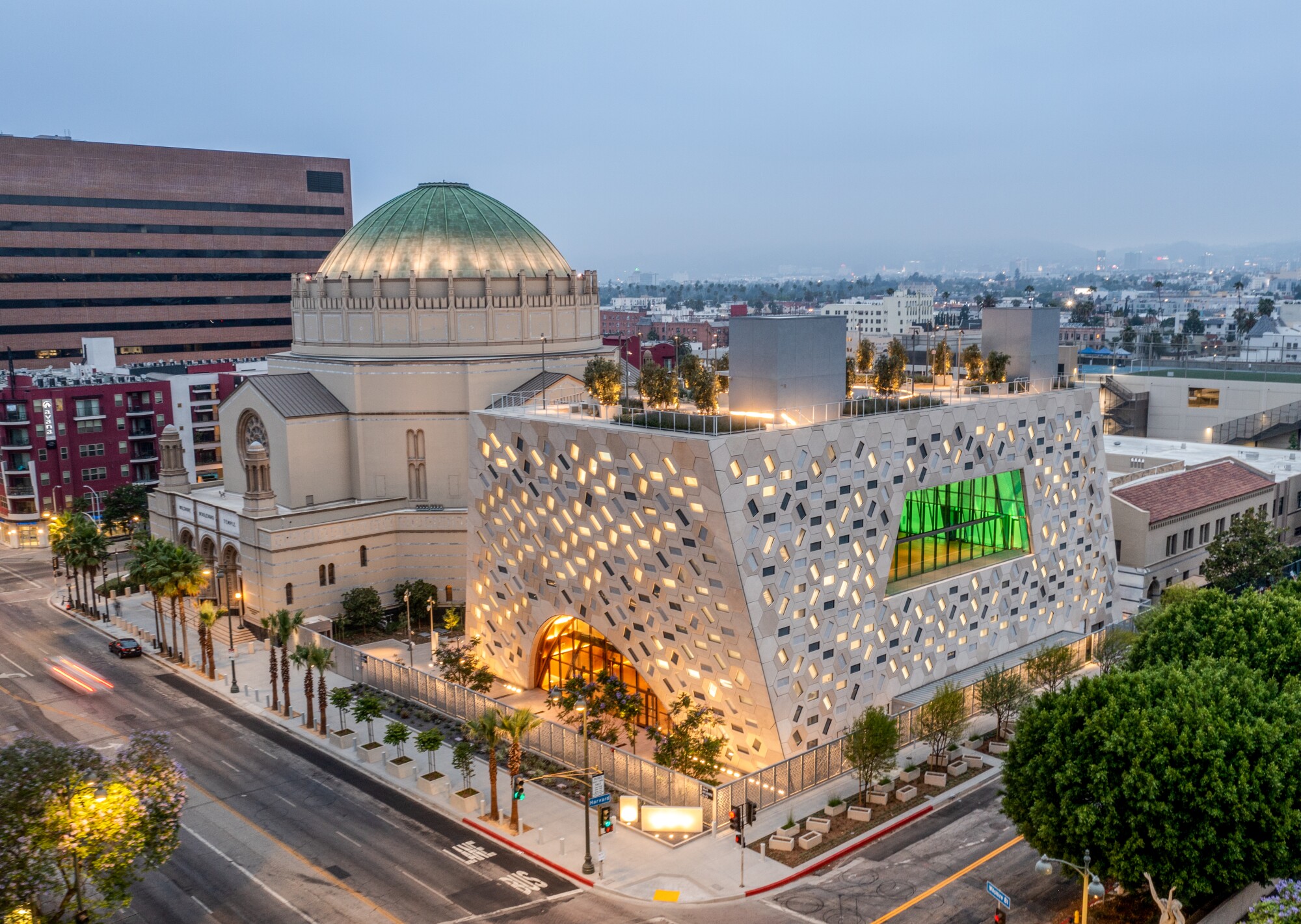
A view of OMA’s Audrey Irmas Pavilion, the 55,000-square-foot match house for the Wilshire Side road Temple.
(Jason O’Rear)
Earlier than diving into the nitty gritty, I wish to commend Rabbi Steve Leder and the congregation on the Wilshire Side road Temple for desiring to one thing bold. The trail of least resistance would had been to position up a by-product match house that vaguely resembled the Byzantine-style structure of the prevailing temple in some bland, new-ish method. That will had been a construction that neither happy nor angry; the type you stroll previous and not take into consideration once more. And that will had been a bummer, for the reason that temple is such a very powerful a part of Southern California historical past.
The Wilshire Side road Temple is the 3rd house of the Congregation of B’nai B’rith, the oldest Jewish congregation in Los Angeles, which used to be based in 1862 — only a dozen years after California changed into a U.S. state and 14 years prior to the transcontinental railroad arrived within the town. Within the Nineteen Twenties, the congregation obtained a assets at Wilshire and Hobart boulevards, in what used to be then a tony, residential a part of L.A. — the “5th Street of the West,” as described by means of the technology’s keen boosters. There, architects S. Tilden Norton, A.M. Edelman and David C. Allison designed a temple sanctuary, finished in 1929, that bears Byzantine and Romanesque thrives with a dramatic dome that spans 100 ft. There are, naturally, some resplendent touches: black marble columns, an excellent rose window and bronze chandeliers.
The construction additionally bears probably the most visible sleights of hand borrowed from the trade that helped construct it. A few of the temple’s maximum vital benefactors have been Hollywood movie moguls Louis B. Mayer, Irving Thalberg, Carl Laemmle and Sid Grauman. This accounts for probably the most structure’s cinematic touches: sanctuary seating organized like a film theater and architectural components that make use of phantasm — corresponding to internal stone partitions that aren’t stone however a far lighter composite (simply knock on them), and a dome whose cerulean oculus comes courtesy of skillfully deployed coloured lighting fixtures. This is a construction that carries early Hollywood in its bones. And it’s taking a look spiffy, having obtained a meticulous $47.5-million renovation in 2013.
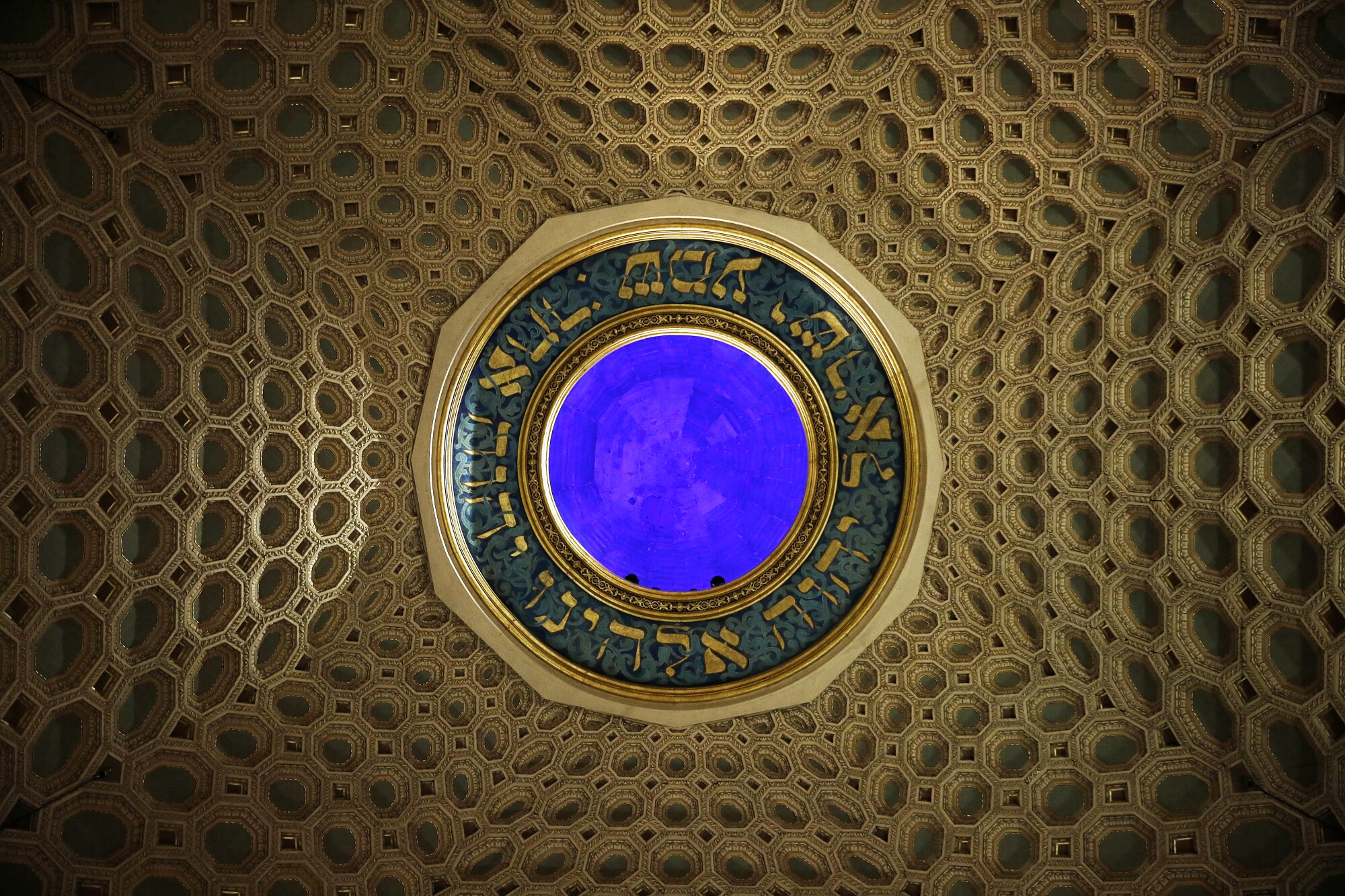
A view of the dome inside the Wilshire Side road Temple, which used to be finished in 1929. The hexagonal sample impressed the facade of the brand new match house.
(Christina Space / Los Angeles Occasions)
Plunking some tedious match corridor subsequent door would, due to this fact, had been a unhappiness — extra so for the reason that the temple’s neighbor to the east is the starkly gorgeous St. Basil’s Catholic Church, a hovering Brutalist construction, devoted in 1969, that used to be designed by means of the corporations of A.C. Martin and Emmett L. Wemple and that includes shocking 3-dimensional stained glass panels by means of the overdue L.A. artist Claire Falkenstein.
The historical past and placement are why I sought after to like — love — the brand new Audrey Irmas Pavilion (which bears the identify of the shopper who gave the lead reward at the $95-million undertaking). However OMA has delivered a construction this is arduous to like.
That’s not sudden, coming from a company recognized for its brash designs. OMA designed the pronged headquarters of China Central Tv (CCTV) in Beijing (finished in 2012) in addition to the Seattle Central Library in Washington state (2004), a significantly well-received construction whose staggered paperwork seem to wish to burst from a cage-like pores and skin.
The 3-story Audrey Irmas Pavilion makes deferential nods to the Wilshire Side road Temple. The honeycomb sample throughout the temple’s dome impressed the honeycomb sample at the new pavilion’s external. The dome’s sweeping arch influenced the type of the pavilion’s ground-floor match house, an extruded arched house that tests in at just about 14,000 sq. ft. The pavilion’s moment tale accommodates a glassy indoor-outdoor chapel and match terrace that respectfully frames perspectives of the temple’s dome and stained glass home windows. As well as, the pavilion leans clear of the temple to create a way of openness between the structures and in order that the interstitial open air areas may really feel much less like alleyways and extra like courtyards.
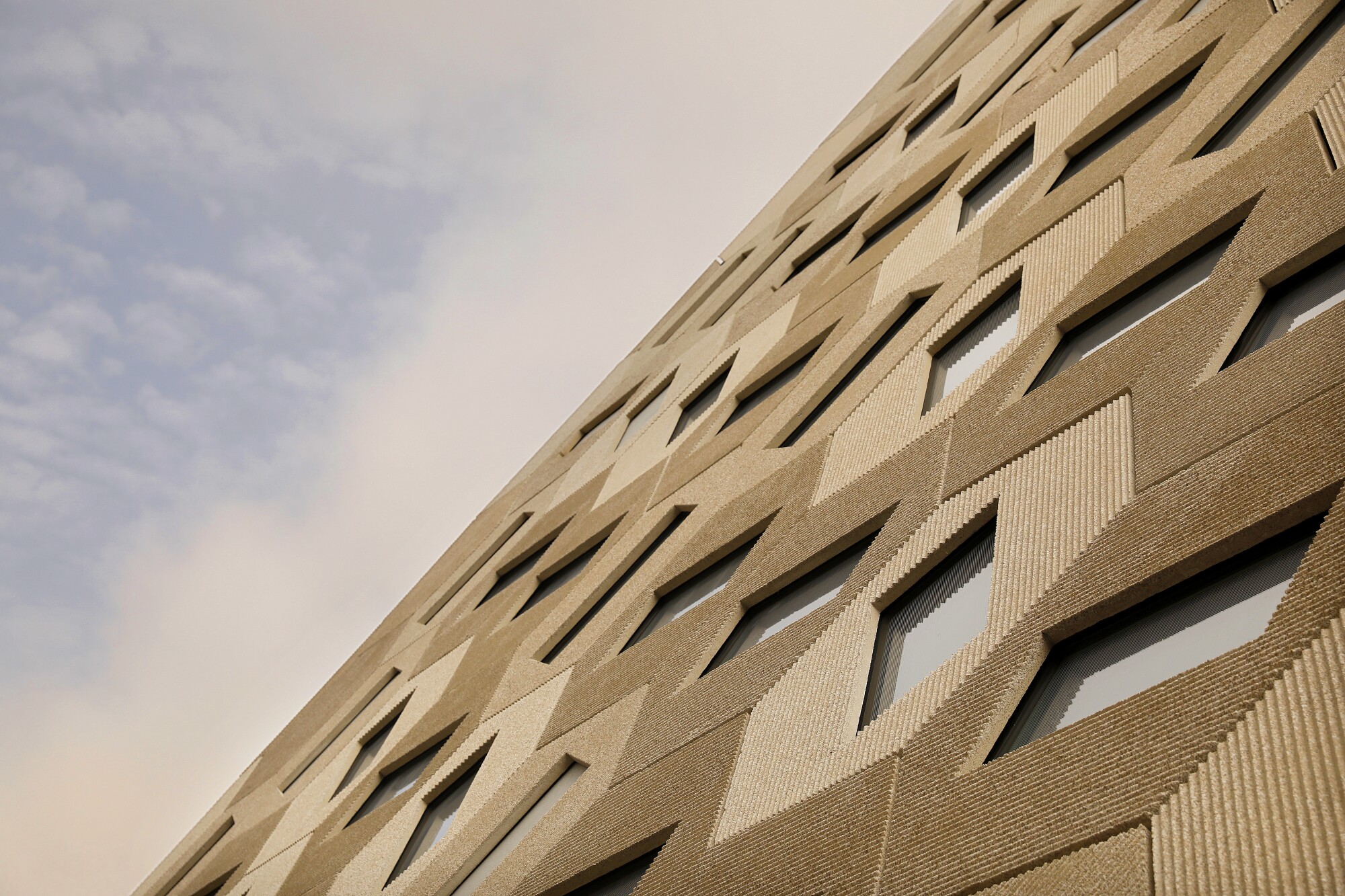
The hexagonal sample of the Audrey Irmas Pavilion consists of hexagon panels constituted of glass fiber bolstered concrete.
(Christina Space / Los Angeles Occasions)
However what sounds excellent on paper doesn’t at all times congeal in actual existence.
The construction’s deferential lean can really feel like a draw back at sure angles. And there’s the surface. To present the construction its honeycomb sample, Shigematsu and his staff encrusted the facade with 1,230 hexagonal panels constituted of glass fiber-reinforced concrete. Each and every panel is about at a novel perspective, and each and every accommodates a window this is set at a novel perspective. The panels are all of the similar buff-colored concrete, however they’re ridged, and relying at the perspective of the solar, the performs on texture and light-weight could make it appear as though they’re other sunglasses. It’s relentless pattern-making — and, when mixed with the construction’s extraordinary angles, supplies few, if any, areas for the attention to leisure. Coco Chanel as soon as famously stated, “Earlier than you allow the home, glance within the replicate and take something off.” OMA’s pavilion places it all on.
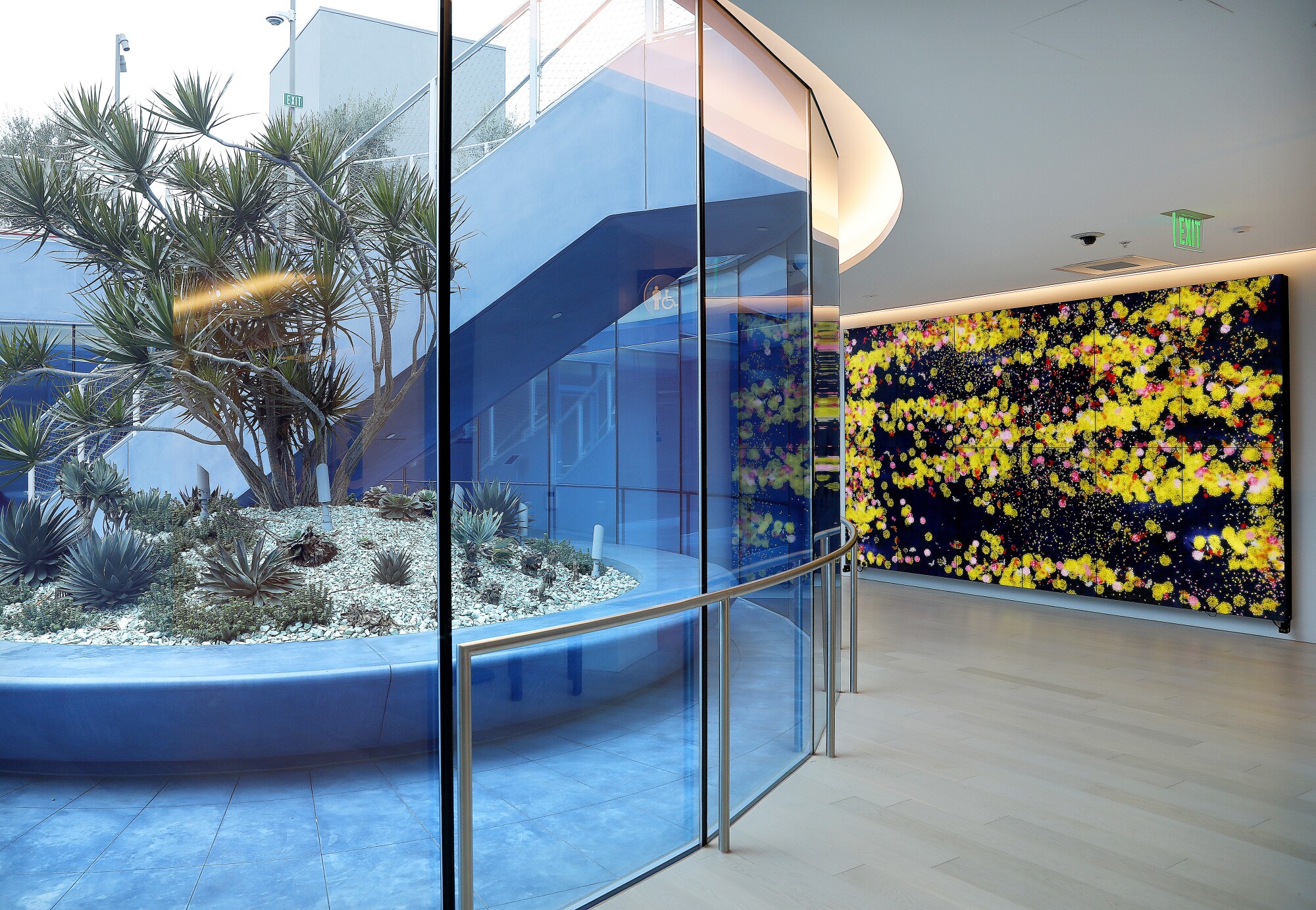
A view of the sunken lawn, visual from GenSpace, a brand new house for seniors.
(Christina Space / Los Angeles Occasions)
Different design components, likewise, lack subtlety. As you ascend the construction’s 3 tales and manner the sky, other colours are presented. The bottom-level match house is wearing a palette of earth tones: Crimson terrazzo tile at the surface is paired with the nice and cozy Sassandra picket veneers of the arched ceiling. Climb a degree, and also you’ll to find your self within the glassy indoor-outdoor chapel and match terrace, which is encased in an electrical colour of emerald inexperienced glass. Stay mountaineering to the 3rd surface and also you’ll come across a sunken lawn (with a panorama design by means of Mia Lehrer of Studio-MLA) this is surrounded by means of partitions painted an azure blue.
OMA is understood for its radical colour remedies, corresponding to the fiery pink corridor throughout the Seattle library. However right here, in what’s purportedly an match house for a non secular group, the web site of weddings and circle of relatives reunions, the palette comes off as Dr. Seuss meets Miami Seaside.
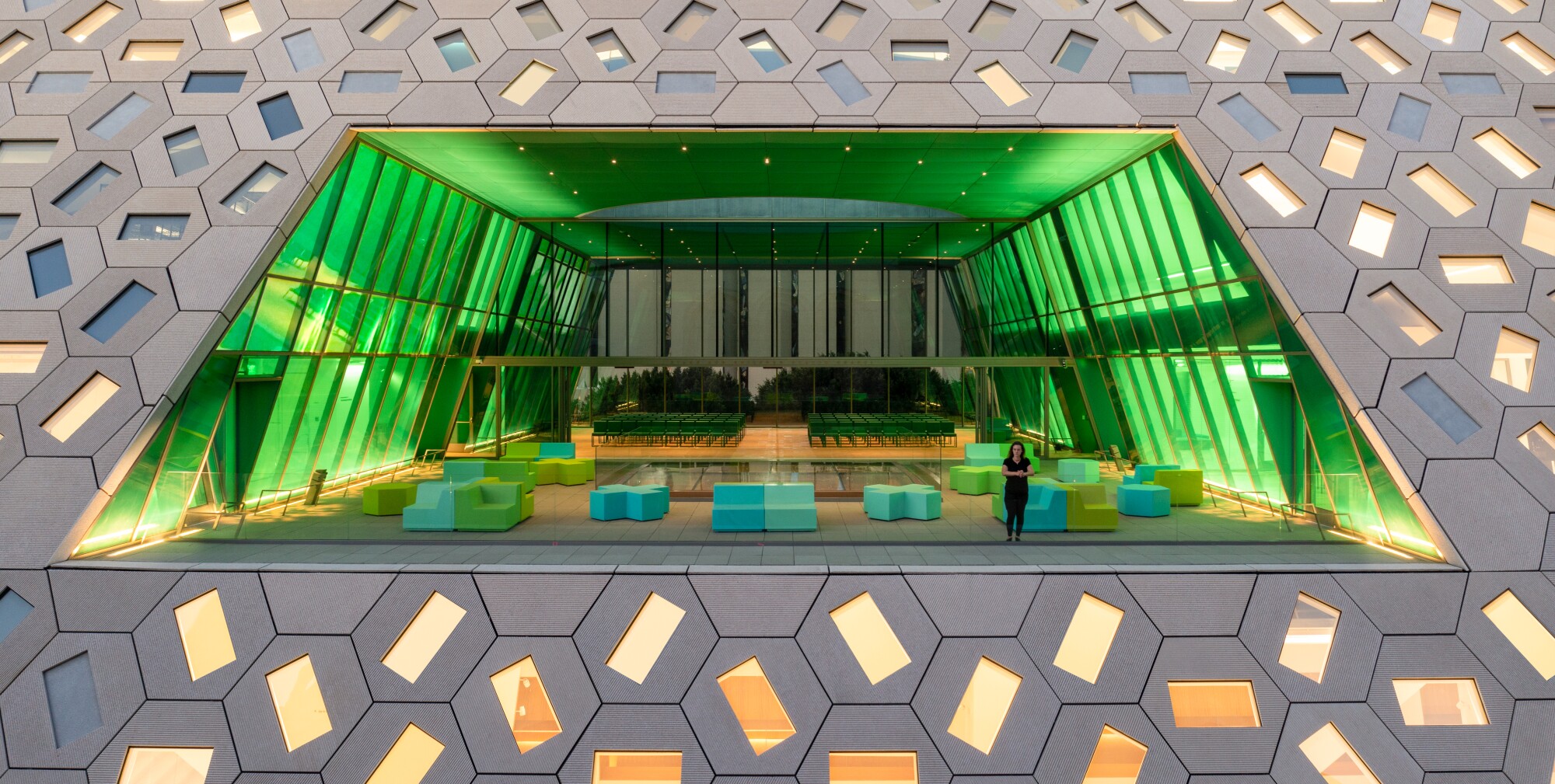
A view of the Audrey Irmas Pavilion’s second-story chapel and open air terrace — rendered in electrical sunglasses of emerald inexperienced.
(Jason O’Rear)
Additionally at the 3rd surface of the pavilion is GenSpace, a brand new group established and funded by means of L.A. philanthropist Wallis Annenberg to function a wellness and cultural heart for community seniors. I will be able to’t recall to mind an structure extra ill-suited to this function. The construction’s angled rooms of gleaming white are this sort of areas that appear designed to harbor a tech corporate or a graphic design company, now not a senior heart that can host messy gardening and art-making categories. Put in inside any such pristine rooms is a lawn hose, an addition that for sure despatched a sit back down the backbone of the architects (to not point out any individual who works in upkeep).
And, after all, there are the Koolhaas-designed mezuzas, the small instances connected to doors that raise a work of inscribed parchment scroll — an object that serves as a reminder of religion. Koolhaas rendered those as oblong stone prisms that adjust in colour relying at the surface. Given the lightness of probably the most interiors and that most of the mezuzas are connected to glass doors, the fabric feels heavy. However the design may just make starchitect-designed mezuzas a factor.
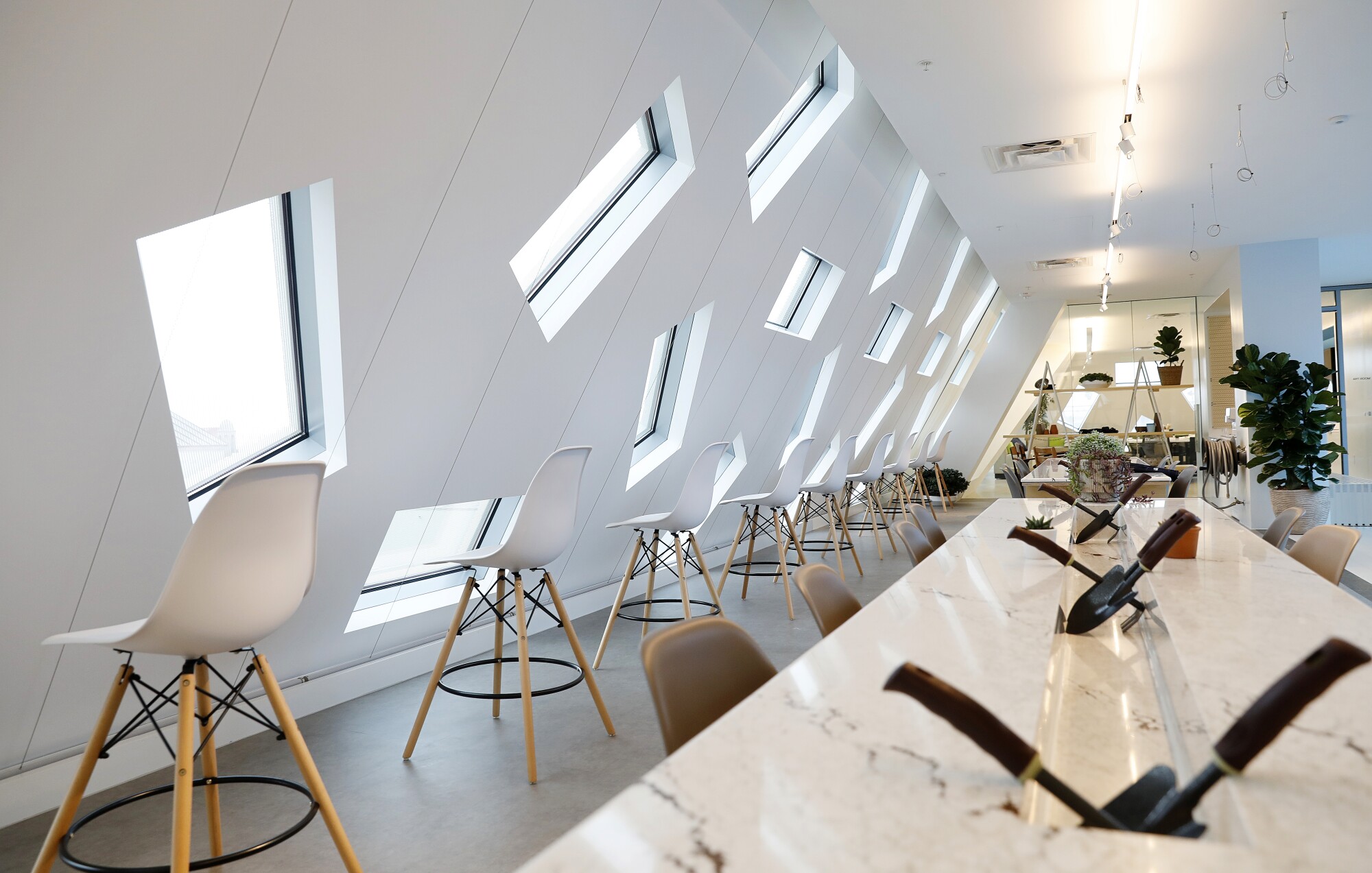
A view of one of the most lecture room spaces inside of GenSpace, a senior wellness and cultural house throughout the Audrey Irmas Pavilion.
(Christina Space / Los Angeles Occasions)
None of because of this the Audrey Irmas Pavilion doesn’t have impressed moments.
Out-of-town architects, steadily seduced by means of visions of L.A. automotive tradition, have a knack for developing structures which can be nice to force previous. Call to mind Rafael Moneo’s cathedral and Coop Himmelblau’s acting arts highschool, which so dramatically body the 101 Highway downtown. The Audrey Irmas Pavilion isn’t any exception. Go back and forth alongside Wilshire Side road in both route and there’s a second during which you’ll catch sight of OMA’s construction leaning out into the street, like some otherworldly neolithic presence. Within the afternoon mild, the home windows sparkle — dappling the temple sanctuary with mirrored mild, but in addition making a confetti sample throughout the pavilion. Throughout that magic hour, the foyer house of the development house transforms into a blinding mild display.
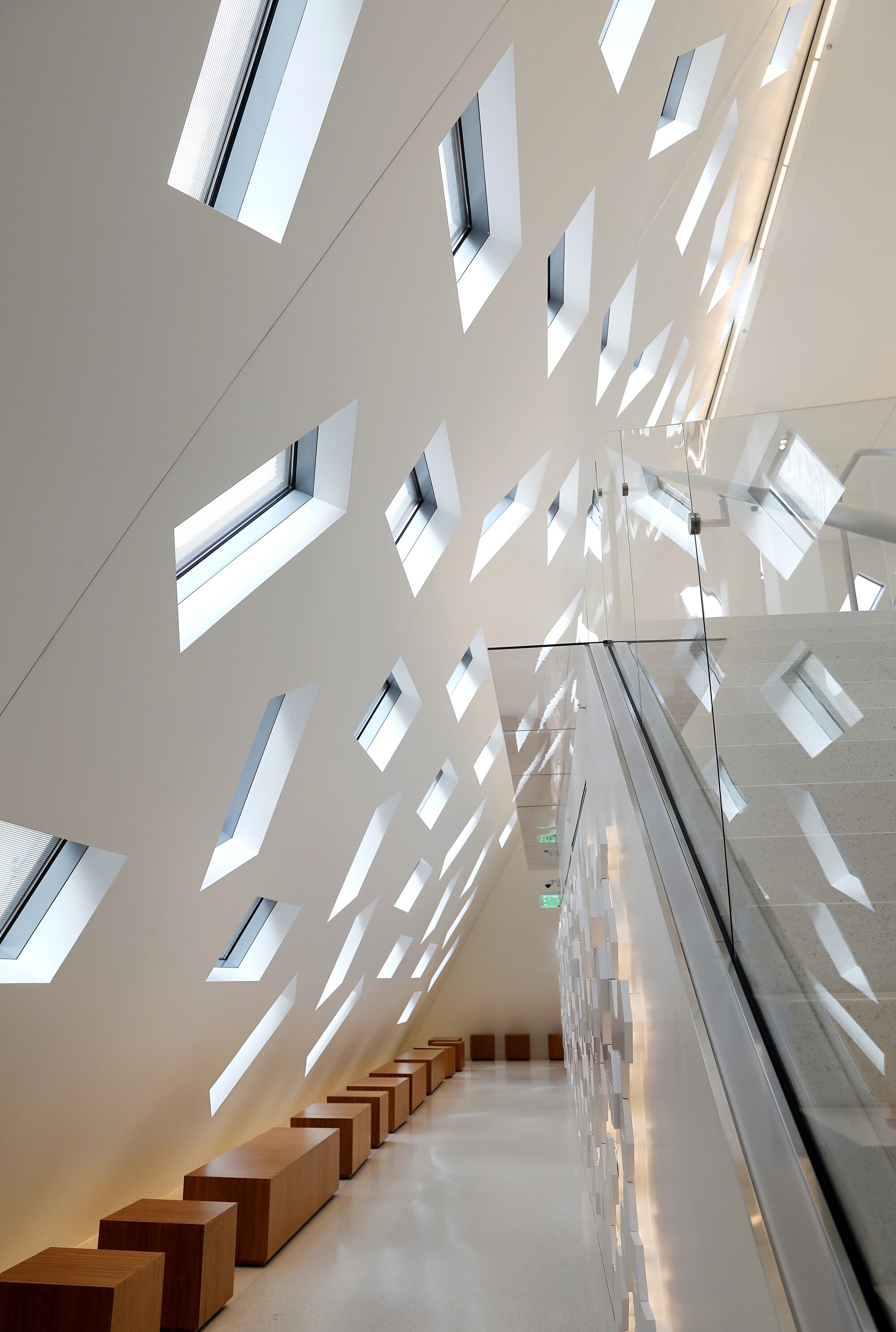
When the afternoon solar hits the pavilion’s Western facet, mild dapples the temple.
(Christina Space / Los Angeles Occasions)
Additionally seductive are the perspectives from the emerald chapel and terrace on the second one surface. At the surface of the terrace is a tumbler cutout that serves as a skylight to the principle match house underneath. This creates a horizontal pool of glass that has the impact of completely shooting the mirrored image of the temple dome subsequent door. It’s a flawless alignment of fabrics and framing.
The construction additionally well takes benefit of the roof, which has a landscaped terrace that encircles the sunken lawn and that from above seems like a pool. The perspectives, which achieve to the Hollywood Hills within the distance, are improbable. Pandemic or no pandemic, this breezy surroundings can be the house to birthday party.
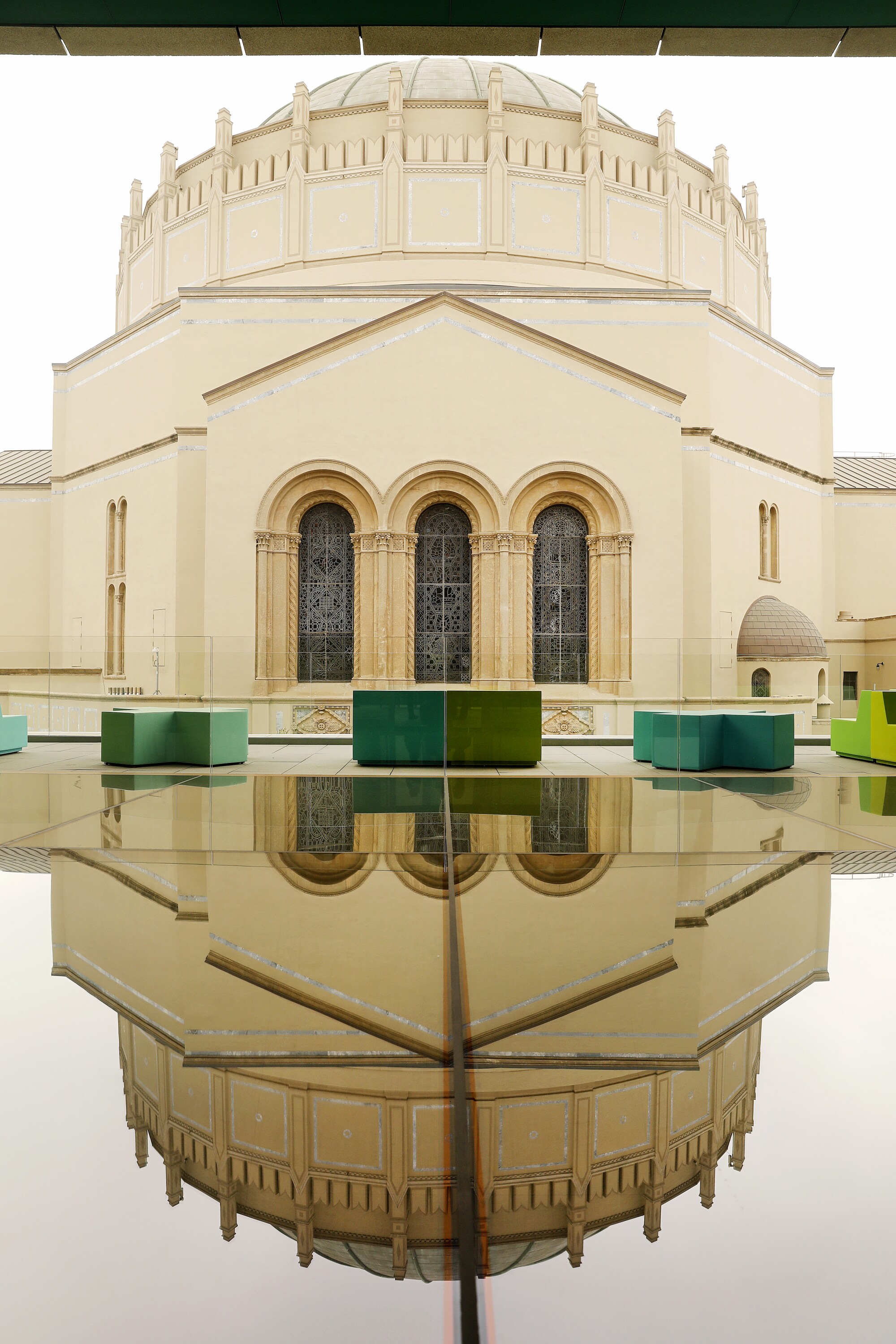
The temple’s dome is mirrored within the glass of the second-story open air terrace of the Audrey Irmas Pavilion.
(Christina Space / Los Angeles Occasions)
However in the long run, OMA’s construction leaves me short of. On their very own, most of the concepts contained inside the pavilion are compelling. Piled in combination, they shape a jumble — one wanting cautious enhancing and much more cautious synthesis. It’s a construction that will get caught inside of its personal head. And that’s this sort of construction that’s arduous to like.
